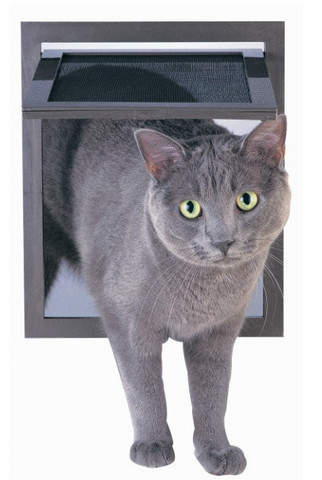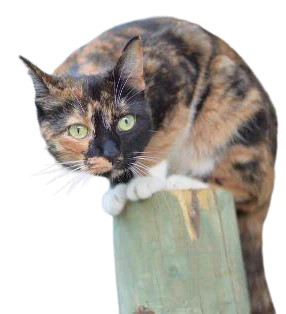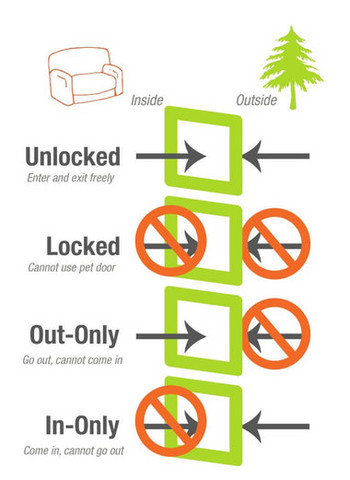Providing your feline friend with independence and outdoor access can significantly enhance their quality of life, and a Cat Pet Door is the ideal solution. These specialized doors, also known as cat flaps, offer cats the freedom to move between indoors and outdoors as they please, while giving you peace of mind and convenience. Whether you’re seeking a simple cat door for interior doors to access a litter box or a robust, secure electronic cat door for exterior walls, understanding the options available is crucial. This guide will explore the various types of cat doors, their features, and how to choose the best one for your home and your cat.
Understanding Cat Pet Doors: Types and Features
The world of cat pet doors is diverse, offering solutions for various home setups and pet owner needs. From basic models to technologically advanced options, knowing the types available will help you narrow down your choices.
Types of Cat Pet Doors
- Door Mount Cat Doors: The most traditional type, these cat doors are designed to be installed directly into standard doors. They are versatile and can be fitted into wood, metal, or PVC doors.
- Wall Mount Cat Doors: Ideal for homes where door installation isn’t feasible or desired, wall mount cat doors can be installed into exterior or interior walls. Often, these require tunnel extensions to accommodate wall thickness.
- Window Mount Cat Doors: Perfect for apartments or rental properties, window cat doors are designed to be installed into sliding glass doors or windows. These are often temporary and require no permanent alterations to your home structure.
- Sliding Glass Door Cat Doors: Specifically designed for sliding patio doors, these cat doors typically come as panel inserts that fit within the existing door frame, offering easy installation and removal.
- Electronic Cat Doors: For enhanced security and control, electronic cat doors use technology like microchip readers or RFID collar keys to allow only your cat access. These can prevent unwanted animals from entering your home.
- Manual Cat Doors: Simpler and often more affordable, manual cat doors usually feature a flap that your cat pushes through. Many come with locking mechanisms, such as 2-way or 4-way locks, for basic control over entry and exit.
Key Features to Consider
When selecting a cat pet door, several features should be considered to ensure it meets your needs and your cat’s comfort:
- Size: Choosing the right size is crucial. The cat door should be large enough for your cat to pass through comfortably without being so large that it compromises security or insulation. Measure your cat’s height and width to determine the appropriate opening size.
- Locking Mechanisms: Depending on your security needs, consider cat doors with locking options. 4-way locking cat doors offer the most flexibility, allowing you to set the door to be fully open, fully locked, entry only, or exit only.
- Material and Durability: Look for cat doors made from durable materials that can withstand weather and regular use. Rigid flaps are generally more durable than flexible vinyl flaps.
- Insulation and Weatherproofing: For exterior cat doors, especially in colder climates, insulation and weather stripping are important to prevent drafts and maintain energy efficiency. Insulated cat doors can significantly reduce heat loss.
- Electronic Features: If security and selective entry are priorities, electronic cat doors with microchip or RFID technology offer advanced control.
- Flap Type: Consider the flap material. Rigid, transparent flaps can be easier for cats to understand and use compared to soft vinyl flaps.
Installation Guide: How to Install a Cat Pet Door
Installing a cat pet door can be a DIY project for many homeowners, especially for door-mounted models. Here’s a general step-by-step guide, but always refer to the specific instructions provided with your chosen cat door.
-
Measure and Mark: Determine the appropriate height for your cat door by measuring your cat from the floor to their belly. Mark this height on the door where you plan to install the flap. Use the template provided with the cat door to draw the cutout shape on the door.
-
Drill Pilot Holes: Drill holes at each corner of the marked cutout area. These pilot holes will provide starting points for your saw.
-
Cut the Opening: Using a jigsaw, carefully cut along the marked lines to create the opening for the cat door. Smooth out any rough edges after cutting.
-
Position the Cat Door: Place the cat door frame into the cutout opening. Mark the screw hole locations on the door using a pencil.
-
Drill Screw Holes: Drill pilot holes for the screws at the marked locations. This will make screwing in the cat door frame easier and prevent wood splitting.
-
Secure the Cat Door: Position the cat door in the opening and screw it into place. Ensure it is securely fastened but not overtightened. Use blanking plugs or screw covers if provided to conceal the screw heads for a cleaner look.
For wall mount cat doors, the installation process is similar but may involve additional steps for creating a tunnel through the wall. Window and sliding glass door cat doors are generally easier to install, often requiring just insertion and minimal adjustments.
 Cat door installation steps
Cat door installation steps
Professional Installation vs. DIY
While many cat owners successfully install cat pet doors themselves, professional installation is an option, especially for more complex installations like wall mounts or electronic models. Professional installers can ensure proper fitting, weatherproofing, and address any structural concerns. If you are not comfortable with DIY projects or require installation in challenging materials like brick or concrete walls, professional installation is recommended.
Training Your Cat to Use a Pet Door
Introducing your cat to their new cat pet door may require patience and positive reinforcement. Cats can be hesitant to try new things, but with the right approach, most cats will learn to use their cat door comfortably.
-
Prop the Flap Open: Initially, prop the cat door flap open so your cat can see through and pass through without resistance. Use treats or toys to lure your cat through the open doorway.
-
Positive Reinforcement: Reward your cat with praise, treats, or toys every time they approach or go through the cat door. Make the experience positive and encouraging.
-
Gradually Lower the Flap: Once your cat is comfortable going through the open doorway, gradually lower the flap. You may need to hold the flap slightly ajar at first, slowly decreasing the opening as your cat gets used to pushing through.
-
Patience and Persistence: Never force your cat through the cat door. This can create fear and anxiety. Be patient and consistent with training. It may take days or even weeks for some cats to fully adjust.
 Cat door training with treats
Cat door training with treats
For cats hesitant about flaps, consider interior cat doors like the PetSafe Cat Corridor, which offers an open doorway design without a flap, ideal for indoor use such as accessing litter boxes in basements or laundry rooms.
Security and Safety with Cat Pet Doors
Security is a primary concern for pet owners considering a cat pet door. While cat doors offer convenience for your pet, it’s important to address potential security risks.
Preventing Unwanted Animals
One of the main concerns is preventing unwanted animals from entering your home through the cat door. Here are several strategies:
- Size Matters: Choosing the smallest cat door size that comfortably fits your cat can deter larger animals.
- Electronic Cat Doors: Electronic cat doors are the most effective solution for selective entry. They use microchip or RFID technology to ensure only your cat can activate the door, preventing access to stray animals or wildlife.
- 4-Way Locking Mechanisms: Manual cat doors with 4-way locks allow you to lock the door completely at night or when you are away, providing a physical barrier.
Electronic vs. Manual Security
Electronic cat doors offer superior security compared to manual models. They eliminate the risk of unwanted animal intrusion when programmed correctly. However, manual cat doors with robust locking mechanisms still provide a basic level of security and are often more affordable. The best choice depends on your individual security needs and budget.
 4-way locking cat door mechanism
4-way locking cat door mechanism
Frequently Asked Questions about Cat Pet Doors
Should I allow my cat to roam freely outside my yard using a cat door?
Cat doors primarily control access between your house and yard. They do not inherently keep your cat contained within your yard. If you are concerned about your cat roaming the neighborhood, a cat door alone will not solve this issue. Consider using a cat door to provide access to a secure catio or enclosed garden area if you want to limit their roaming. For indoor confinement, cat doors can be useful for restricting access within the house, such as to a specific room like a garage or basement.
How do I install a cat door?
The installation process depends on the type of cat door and the surface you are installing it into. Generally, it involves measuring, marking, cutting an opening, and securing the cat door frame. Refer to the installation guide provided with your specific cat door model. For door installations, basic tools like a drill, jigsaw, and screwdriver are usually sufficient. Wall installations may require additional tools and tunnel extensions.
Will my cat actually use the pet door?
Most cats can physically use a cat pet door, but their willingness to use it depends on their individual personality and comfort level. Positive reinforcement and gradual training are key to encouraging your cat to use their new cat door. Some cats adapt quickly, while others may take more time and patience. Reducing flap resistance or using training modes (if available on electronic doors) can also help.
How can a cat door prevent other animals from entering my home?
For manual cat doors, choosing a smaller size can deter larger animals. However, electronic cat doors offer the best protection against unwanted intruders. These doors use microchip or RFID technology to recognize only your cat, preventing access to other animals. Some models, like the Cat Mate 359, even include timer settings for added security.
Will I need to replace parts of the cat door frequently?
Most cat doors are designed for durability. Cat doors with rigid flaps, typically made from acrylic, are very long-lasting and resistant to wear and tear. Flexible vinyl flaps may be more susceptible to damage over time and may require replacement, especially after harsh weather or heavy use.
What is the difference between a cat door and a dog door?
While the terms are sometimes used interchangeably, traditionally, cat doors are smaller, often square-shaped, and feature rigid flaps. They are designed specifically for cats’ smaller size and movement patterns. Dog doors are typically larger and come in various sizes to accommodate different dog breeds. However, many pet owners use cat doors and dog doors based on features rather than strict categorization. If a pet door meets your pet’s needs and your home requirements, it’s a suitable choice regardless of whether it’s marketed as a “cat door” or “dog door.”
What is a 4-way lock on a cat door?
A 4-way lock provides four locking options for manual cat doors, offering greater control over your pet’s access:
- Unlocked: Allows entry and exit in both directions.
- Locked: Prevents entry and exit in both directions.
- Out-Only: Allows exit but prevents re-entry.
- In-Only: Allows entry but prevents exit.
This versatility makes 4-way locking cat doors a practical choice for managing your cat’s access at different times of the day or in specific situations.
What is the best type of cat door for cold weather?
For cold climates, insulated cat doors are essential. Look for cat doors that feature double or triple flaps, magnetic seals, and weather stripping to minimize drafts and heat loss. The Endura Flap Pet Door and Cat Mate 221 are excellent options known for their energy efficiency and weather resistance.
Conclusion
Choosing the right cat pet door involves considering your cat’s needs, your home’s structure, and your security priorities. Whether you opt for a basic manual flap or a high-tech electronic cat door, the benefits of providing your cat with freedom and independence are undeniable. By understanding the types of cat doors available and their features, you can make an informed decision and select the perfect cat pet door to enhance both your and your feline companion’s lives.
